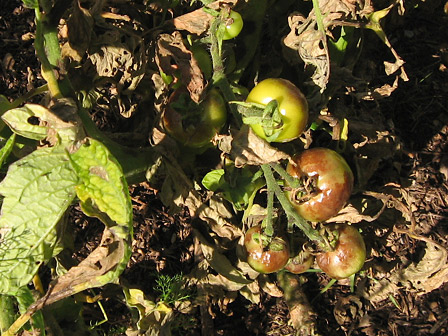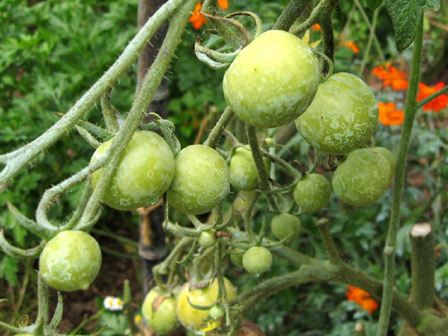Happy New Year! We are happy to say that 2007 is off to a good start here on the Farmlet. We have just been enjoying a much-needed spell of warm summer rain. The garden is producing more beans and zucchinis than we can eat, and the animals all look plump and happy.
Still, there is one piece of bad news on the garden front: Many of our tomatoes have succumbed to a bad case of blight over the Christmas period. I’d noticed the beginnings of it before Christmas, and decided we should probably apply a copper spray. Well, Christmas came and went with no action taken, and the result is rather a sad sight to behold.

Tomato plants covered with blight
Northland’s very humid climate is far from ideal for growing tomatoes, even at the best of times. We should have stayed on high blight alert and acted quickly to take care of our tomatoes — especially knowing that we have copper deficient soil conditions! (The previous owner of our property discovered this when she had the soil tested.) Plants grown on copper deficient soils are known to be more vulnerable to blight.
We have pulled out and disposed of the tomato plants that were too diseased to save. The rest have had infected leaves removed, and will be sprayed with bordeaux mix to slow further spread of the blight. Bordeaux mix is copper suphate and hydrated lime mixed with water. It is an “organically approved” treatment, but needs to be used with caution. Copper can build up to toxic levels in the soil if the preparation is over-used. Since our soil is copper deficient in any case, this will not be an immediate problem. I believe that applying dolomite at the same time helps to mitigate any ill effects of the copper.

The blue-green copper residue from the bordeaux mix can be seen on the plants that survived the outbreak
We hope that in due course our soil will be healthy enough that we will not have to resort to using bordeaux mix to stem the spread of blight. Also, foliar applications of compost tea throughout the growing season are supposed to help prevent the problem arising in the first place. We’d like to give this a go. Good garden hygiene, and careful removal of infected leaves can also help avoid the problem, but it obviously wasn’t enough this year.
The tomato news is not all bad! We succession-planted our tomatoes, and made sure to put them in a couple of different areas. One bed that was planted later is still a lot cleaner than the rest, and looks likely to survive with the right care. We have also just planted out another late set of tomato seedlings. We are hoping to do better with these ones!